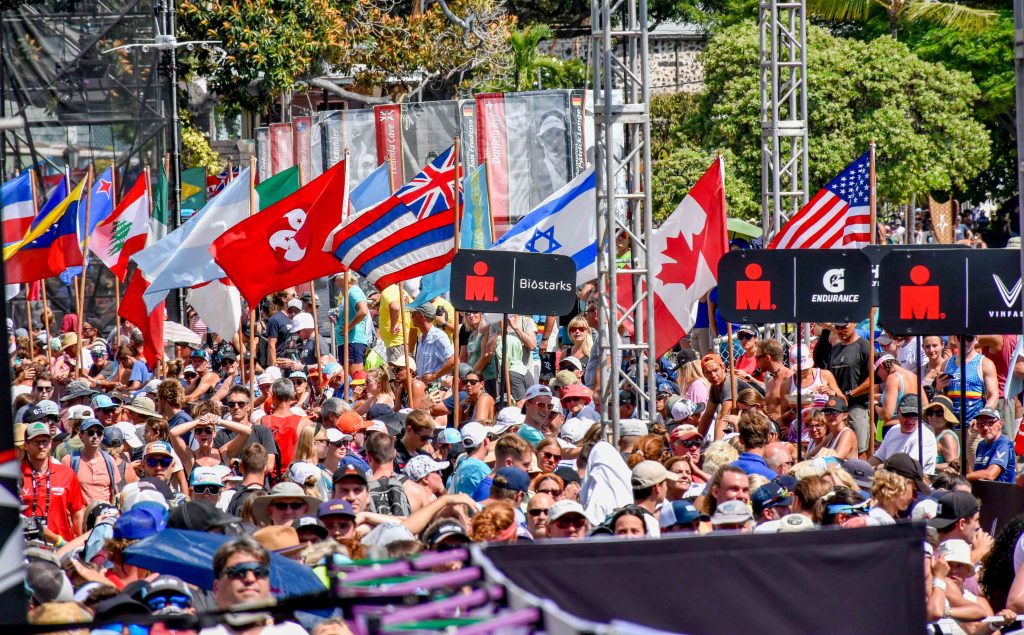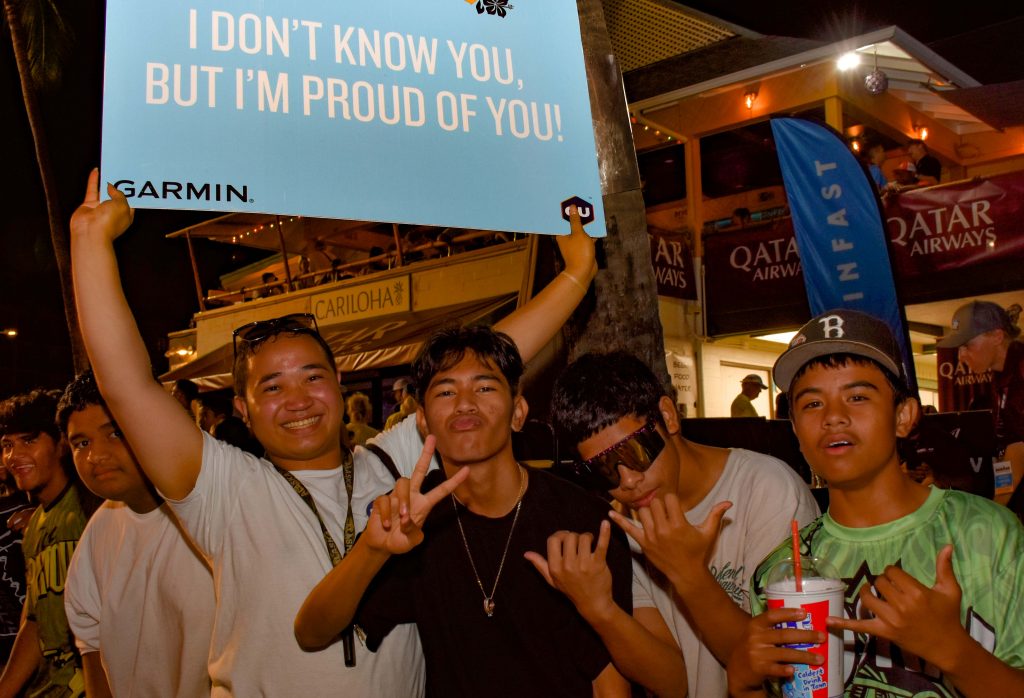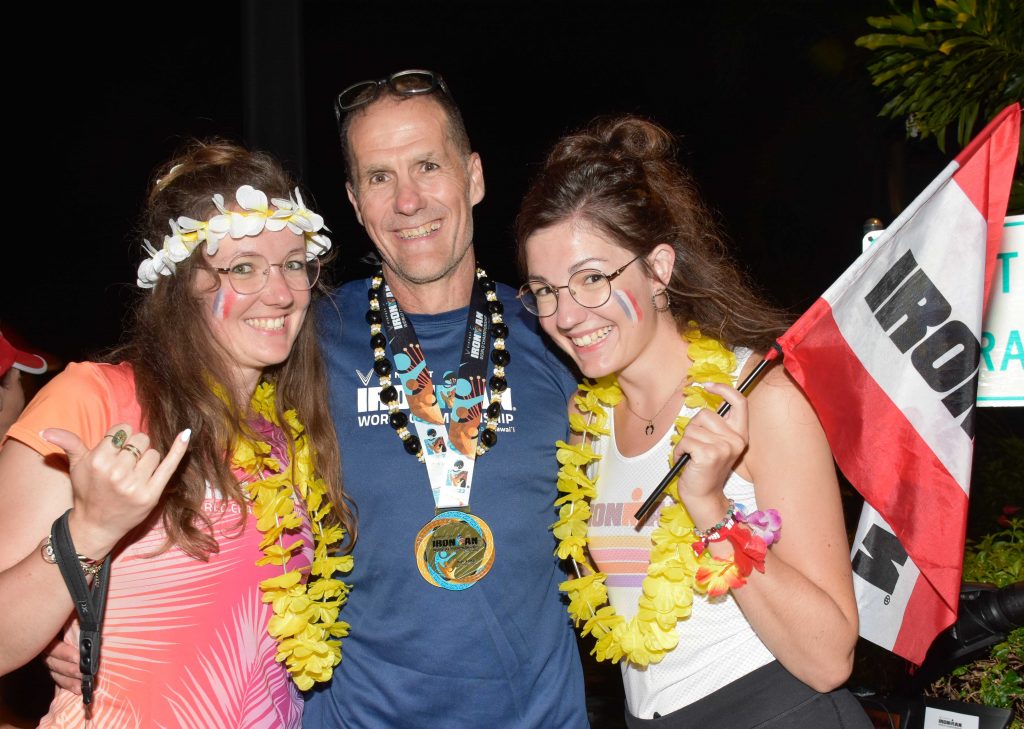Many of the 20,000-plus people who flocked to Kailua-Kona last week for the 2022 VinFast Ironman World Championship have left the island. The cones and road closure signs are gone. The country flags that lined a large stretch of Aliʻi Drive have been packed away. Normalcy has returned after a wild week filled with the aloha spirit.
The Ironman World Championship has called Kona home since 1981, but it had been three years since the event was held here due to the COVID-19 pandemic. The 2020 championship was canceled and the 2021 event was relocated to St. George, Utah.

The triathlon’s return to the Big Island brought a big change. Instead of one day of racing, there would be two to accommodate the backlog of people who had qualified for the championship but could not compete due to the pandemic. The number of participants doubled to about 5,200.
The addition of a race in the middle of the work week irked some downtown business owners who closed due to road closures and the mayhem. Some community members were insulted that they were not consulted about the two-day format, saying the small town of Kona with a population of about 23,000 couldn’t can’t support the onslaught of thousands more participants and their supporters.
But much of the community also welcomed the return of the world-famous sporting event and the money it brings to the island.
The Ironman World Championship is like no other competition, with the will of the human spirit and support of a community on full display. Thousands of people line up along the course cheering for the pro triathletes. They also root just as hard for the everyday people simply trying to fulfill their dream and finish the grueling 140.6-mile monster course before the 17-hour time limit. You don’t hear booing.
Nine hours after Norwegian Gustav Iden set a course record to win the men’s championship on Saturday, the music still blared at the finish line. The crowd that remained cheered loudly for every last one of the record 4,694 competitors to cross the finish line after surviving the 2.4-mile swim in Kailua Bay, 112-mile bike and 26.2-mile marathon run on a day that featured scorching heat, high humidity and wind.
One man from Micronesia held up a sign that said: “I DON’T KNOW YOU, BUT I’M PROUD OF YOU.”

As the clock ticked toward midnight on Saturday, most of pharmacist Chad Cartwright’s 18 friends and family members who traveled from Lubbock, Texas to cheer him on were along Ali’i Drive — patiently waiting for the 49-year-old to finish.
“Oh yeah, he’ll make it. He always makes it,” said Cartwright’s father, who said the “older ones” and young kids had to go to bed. “But we’ve been having fun cheering everybody on.”
Cartwright did make it. Despite a crash on the bike course that gave him painful road rash, he waved a Texas flag as he crossed the finish line at 16:24:16.
“Chad Cartwright, you did it man. You are an Ironman,” the announcer said with the same enthusiasm as if Cartwright had won the race.
The finishers included: 44 pro men, 32 pro women, 1,169 age group women, 3,435 age group men, 8 handcycles and 6 physically challenged.
Big Island resident Tamae Taylor, originally from Japan, was one of the 5,000-plus volunteers who made the race possible. She was a “people catcher,” whose job literally was to catch exuberant but exhausted triathletes who are in danger of collapsing after crossing the finish line.
“I love this island. I love this atmosphere and energy,” Taylor said. “I love the big smiles of people. That makes us happy.”
Ironman World Championship Race Director Diana Bertsch and some of her team live on the Big Island.
“There is a special magic in Kona,” she said.
She also knew that adding the second race would add more burden to the community that she was deeply familiar with.
Her team began the Live Ahoha campaign this year to educate participants and visitors about responsible tourism by respecting the land, culture, nature and people of the Big Island. More than 20,000 people took the Island of Hawai’i Pono Pledge.
This year’s the championship’s theme was Kū Like (stand together).
“We knew it was important more than ever to come together this year,” Bertsch said. “People are still dealing with challenges. Sporting events bring people together. They see the good in humanity and watch people fulfill their dreams.”
Bertsch cited the inspirational story of Chris Nikic, who became the first athlete with Down Syndrome to finish the Ironman World Championship. Led Zeppelin’s “Whole Lotta Love” blared as Nikic jumped into the arms of his volunteer guide, Dan Grieb, who was tethered to him during the swim and by his side for the run and bike for all 16 hours, 31 minutes and 27 seconds.
American Chelsea Sodaro, who won the women’s pro race earlier in the day, was among those at the finish line to congratulate him.
Bertsch said Nikic’s accomplishment shows “anything is possible.”
It was quite a feat for everyone to finish, considering male pro winner Iden said after setting the course record: “That was so freaking hard.” And race favorite Kristian Blummenfelt of Norway collapsed after finishing and was taken to the medical tent on a stretcher.
The Ironman World Championship began humbly but has grown into an iconic global event that has put Kona on the world stage. This year, people from around the world watched about 5,200 participants from 92 countries.
They include Travis Beckley of Australia: “My first time here was 10 years ago. I was watching my mate and got inspired. It took 10 years to get back so I could do it. I love the atmosphere. But it definitely was the hardest course I’ve ever done. But that’s what makes it special.”
Beckley planned to celebrate his finish with a Kona Longboard.
Laurent Delannoy from France, who competed in the 55-59 age group, was taking photos with his bike and two adult daughters after he finished in 11:58:24.
“He’s amazing,” said his daughter Chloe, who was giggling with her sister. “He is an Ironman.”

Bertsch said she believes this year’s championship brought an estimated $100 million to the island considering an economic impact study by the firm Markrich Research in 2019 found that year’s World Championship in Kona generated about $75 million.
Since 2019, the cost of just about everything on the Big Island has increased. There also were thousands more people at this year’s championship.
There was such demand for Uber, that the cost of a ride from the airport to Ali’i Drive tripled to more than $75 on the evening before the first day of racing. One local resident rented out his car for $1,000 for five days.
Ironman finisher John Hannan from Springfield, Va., had seven supporters with him. While they weren’t watching the race, they were visiting Hawai’i Volcanos National Park, going on a coffee plantation tour and visiting the Kona Salt Farm.
Beckley from Australia said his friends and family also have been enjoying touring the BIg Island, and he plans to play a round of golf with his dad, “once I can walk properly.”
Bertsch said she and her team knew the change to a two-race format would be met with mixed emotions by the competitors, as well as the community. Some of the pro women athletes were not completely sold before their race that it would be a good thing, but the top five finishers said they liked having the limelight to themselves after experiencing it.
The format enabled the focus to be on the women, who did not disappoint with a great race that featured Sodaro, a new mom, shocking the best women’s field in Kona history to win in 8:33:46. She was met at the finish line by her parents, husband and 18-month-old daughter, Skye.
“I really like the two-day format,” said pro woman Laura Philipp of Germany, who finished fourth. “[But] I’m not too sure if Kona could handle it. I think it was super, super busy.”
But she added she was excited to see the men’s race “maybe drinking a cocktail. It will be a new and cool experience. Maybe we girls can join up and enjoy them suffering.”
The pro men definitely suffered. They battled so hard that the first four finishers — Iden, Sam Laidlow, Kristian Blummenfelt and Max Neumann — all smashed the previous course record held by three-time Ironman World Champ Jan Frodeno on a day where conditions were tough. Iden finished in 7:40:24 to beat the record by nearly 11 minutes.
Ironman officials tried to get the word out about the change in format months in advance through a variety of community meetings and one-on-one discussions with businesses. Bertsch said her team also tried to do everything it could to mitigate the disruption.
“We had a lot of community support and people who were happy we are here,” she said Sunday. “Definitely, we have heard from some who are not happy with the two-day format.”
The extra race day also meant more volunteers were needed, and there was a shortage just a week before the race. It led to aid stations being spaced out more than they have in the past on the bike and race courses.
Bertsch said it always is the case that many volunteer positions are filled shortly before the race. She also said that there was inefficiency before in the spacing of the aid stations.
Many competitors praised the volunteers and their enthusiasm.
“Cheering is part of our job description,” said one volunteer working security detail along Aliʻi Drive.
Ironman already has announced its 2023 World Championship in Kona also will have two race days, one for the men and one for the women. Bertsch said her team is taking the lessons learned from this year and will apply them in 2023.
She also said no decisions have been made about the format beyond 2023. But when a decision is made, it will be in consultation with Hawai’i County and the community.
She said it is the aloha spirit of the community, the culture and the committed volunteers that have made the Ironman World Championship the iconic global event it has become.
“Hawai’i is the birthplace of Ironman,” Bertsch said. “We have been here and never left.”
